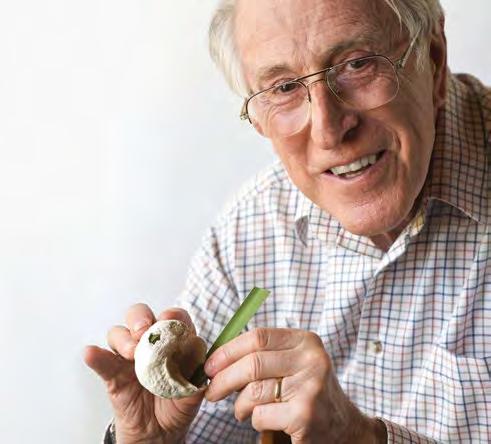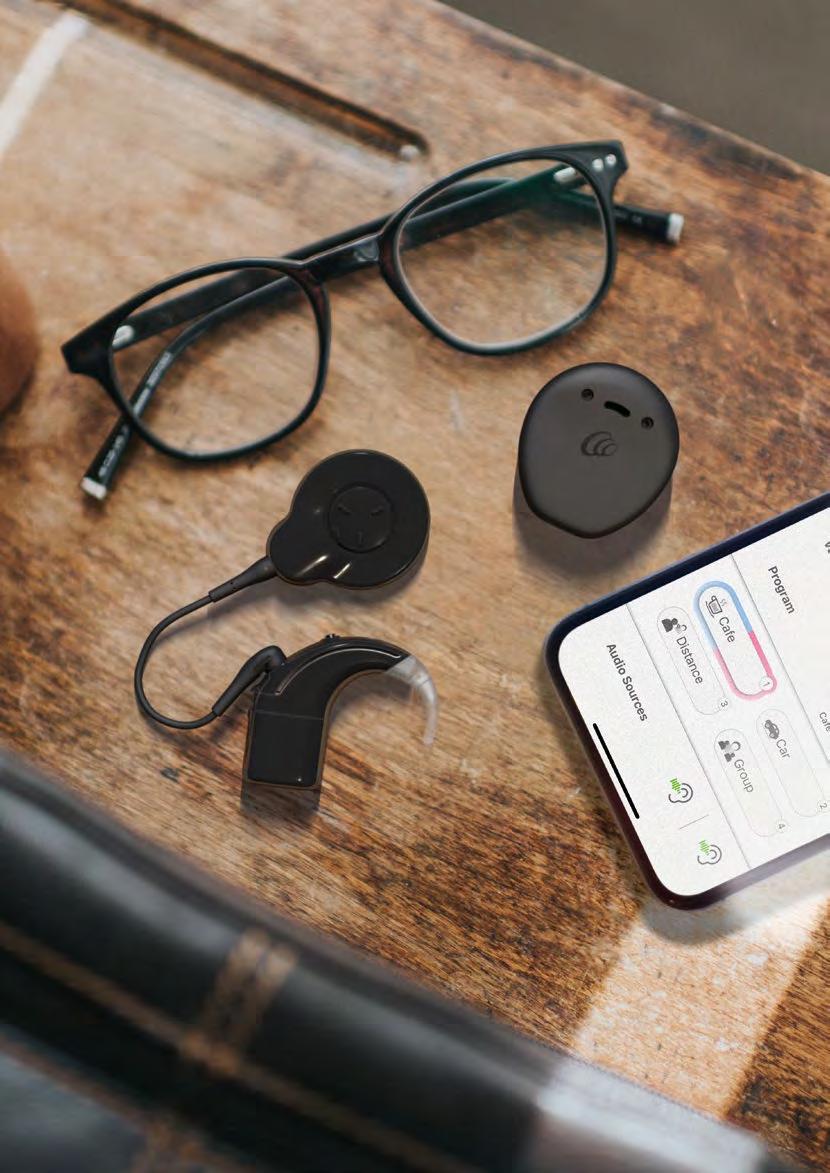

“My loved ones notice that I can hear better and keep up with conversations a lot more.”
Tina, Cochlear Nucleus System recipient



“My loved ones notice that I can hear better and keep up with conversations a lot more.”
Tina, Cochlear Nucleus System recipient
How you choose to treat hearing loss is an important decision. Whether you are exploring options for yourself or someone you care for, you want to be sure you’re making the best choice possible.
This guide is designed to help you understand how the Cochlear™ Nucleus® System works and all that it offers to help those with hearing loss engage with the world of sound.
Our story started more than 40 years ago when Professor Graeme Clark invented the first multi-channel cochlear implant. Inspired by his father’s own hearing loss, he persevered for decades to find a treatment. His breakthrough led to the foundation of Cochlear, where we continue his work today. Since then, we've provided more than 650,000 implantable devices, helping people of all ages to hear and live the life they want. We are committed to helping you or your loved one achieve the best possible hearing every day. This means providing innovative hearing solutions and ongoing support throughout your hearing journey – today and into the future.
 Professor Graeme Clark AC, Inventor of the multi-channel cochlear implant
Professor Graeme Clark AC, Inventor of the multi-channel cochlear implant

While hearing aids work by amplifying sounds, cochlear implants are different. They bypass the damaged part of the ear and stimulate the hearing nerve directly. This enhances the clarity of sound and improves your ability to understand speech.
There are two parts to a cochlear implant system.
The implant is an electronic device that’s placed under the skin and into the inner ear to help deliver hearing, along with the sound processor.
The sound processor sits on your head. There are two types of sound processors, worn either behind-the-ear or off-the-ear. Two microphones pick up sound waves, which are converted into digital information that’s transferred to the implant. The hearing nerve then sends this information to the brain to be interpreted as sound.


Whether you’ve lived with hearing loss for years and relied on hearing aids, or you or your loved one has received a recent diagnosis, selecting the best hearing treatment can help you enjoy more of what you love.
Our primary focus is creating innovations that make a difference to the moments that matter over time. Here are some considerations to help guide your research:
The ongoing safety and reliability of your hearing solution is very important. Our industry-leading reliability and rigorous product testing mean you can expect the most reliable cochlear implant system on the market.1
Choose a hearing solution that's designed to deliver measurable hearing performance and helps you in different situations – from a quiet evening at home to a noisy classroom or bustling workplace. Cochlear sound processors are designed to automatically adjust your hearing settings to deliver clearer sound and improve your listening experience.2-8
You'll want to stream sound directly to your sound processor from smartphones, TVs and more. Cochlear offers you new ways to access sound and connect to your world. Our latest sound processor is ready to connect you more easily – in more places and from more devices than ever before.9-11,¥
Choosing a cochlear implant is more than choosing a device. It’s about choosing a partner who supports you and helps you hear with confidence. With Cochlear you’ll be part of the world’s largest hearing implant community, with access to resources, events and more.
Get access to the clinic by using our Remote Care± solutions to do a hearing check or video appointment with your clinician from the comfort of your home.

“With my cochlear implant I feel like anything is possible.”
Kuhu, Cochlear Nucleus System recipient
Choosing a cochlear implant is an important step towards a lifetime of hearing.*
Our implants are designed to help you get back the sounds you've been missing, or haven’t experienced before,12,13 by helping to give you the clarity you need to hear better and understand speech, even in noisy situations.14-16
When considering a cochlear implant, it’s important to understand how it works. The implant includes an electrode implanted inside the cochlea and delivers sound to the inner ear. We make the slimmest implant and electrodes in the industry, as a proven part of supporting the long term health of your cochlea.17-19
As a step towards a lifetime of hearing performance, inner ear (cochlea) health is important to help maintain good hearing outcomes and should be the goal when choosing a cochlear implant. We provide unique hearing implant solutions that can support cochlea health and may lead to better long-term hearing outcomes.17
If you ever need an MRI, our Cochlear Nucleus Profile ™ Plus Series Implant∞ is designed to allow for MRI scans.
Your hearing health professional or surgeon will discuss which implant is right for you.
When you choose Cochlear you are choosing the most reliable cochlear implants available1
Cochlear Nucleus Implants: Reliability1



650,000+ implantable devices provided by Cochlear since 1981 - more than any other company in implantable hearing.20,21
Designed to help you hear your best, Cochlear sound processors demonstrate proven hearing performance2-8 and offer the latest technology.
Nucleus 8 Sound Processor
Explore all the possibilities with the world’s smallest and lightest behind-theear sound processor. 22 The Nucleus 8 Sound Processor brings together next-generation Bluetooth ® connectivity¥ and smarter hearing performance so you can experience your best hearing. 2-7,-9-11
Kanso® 2 Sound Processor
The Nucleus Kanso® 2 Sound Processor is our latest off-theear sound processor. It offers direct streaming from compatible devices† and easy-to-use and award-winning design, all wrapped up in the smallest and lightest rechargeable off-the-ear sound processor available. 23



Nucleus 8 is the world’s smallest & lightest
behind-the-ear sound processor that’s ready for the next generation of Bluetooth.

first & only
off-the-ear sound processor to offer direct streaming from compatible Apple or Android devices.24
Behind-the-ear Cochlear Nucleus 8 Sound Processor Off-the-ear Cochlear Nucleus Kanso 2 Sound Processor Cochlear Nucleus 8 Sound Processor Cochlear Nucleus Kanso 2 Sound Processor


No matter where you are or what environment you are in, our sound processors help you hear more clearly2, 4-7,25 so you can get on with what really matters.
Our sound processors have smart hearing technology that works by detecting the distinctive aspects of sound and automatically adjusting the settings to the listening environment. Whether you are listening to music, in a busy cafe with friends, or outside on a windy day, our sound processing technology is designed to to help you hear your best as you move throughout your day.2,4-7
Holding a conversation can be challenging when there is a lot of background noise, like in a train station or cafe. With ForwardFocus technology, our sound processors can reduce the noise coming from behind you so you can more easily enjoy face-to-face conversations.25,26,#
Speech: helps you hear speech more clearly
Speech in noise: to help you with conversations in noise
Noise: helps you hear comfortably in noisy situations
Wind: helps you hear comfortably in windy conditions
Quiet: allows you to hear soft sounds in quiet environments
Music: helps you enjoy and listen to music
ForwardFocus: reduces the noise coming from behind you
Do more of what you love and hear more every day when you connect to your compatible smartphone and favourite wireless devices.
Smartphones and tablets have become such a big part of our lives. They give us more ways to connect with our loved ones and friends, keep us up to date and connect us to the world around us. From jumping into video work calls, watching a movie or talking to friends or family, technology allows you to hear more in more places.
You can stream sound directly from your compatible Apple and Android smartphone to Nucleus sound processors.†
There are so many ways you can connect, whether it's video calls to catch up with friends, family, work colleagues and school, hearing phone conversations more clearly,3,27,28 streaming your favourite TV shows and movies or listening to the latest podcasts.
Ready for next-generation Bluetooth ® LE Audio technology¥, the Nucleus 8 Sound Processor will make it easier to bring sound to you – in more places and from more devices than ever before.9-11
You’ll be able to connect directly to any compatible device at home, work or school and to broadcasts at public venues such as airports, conference centres and theatres with Bluetooth Auracast™ .
Beyond smartphones and nextgeneration Bluetooth ® LE Audio technology¥, we also offer purposemade accessories to help you when you need it most.
Our Cochlear True Wireless accessories are designed to help you better connect to work meetings, participate in classroom discussions or enjoy a family movie night –the choice is yours.


Looking to splash in the pool, swing high at the playground or work out at the gym? With our range of accessories, you have more opportunities to unleash your potential and live life to the full.
If you’re getting active, there is a range of solutions to help keep your sound processor secure. For both adults and children, we feature a range of optional accessories, including those designed especially for smaller ears, so you know the sound processor is safe and secure.
With a choice of disposable and rechargeable batteries, you have the flexibility to manage your battery power use all day, no matter where you are. And you can easily track your rechargeable battery usage with the Nucleus Smart App.«
Swim, soak and splash with Aqua+
Being able to play in and around water is one of life’s joys. Nucleus sound processors come with the highest water resistance rating (IP68), so they’re sweatproof and splashproof, even in humid conditions. 29, 30,^,+ And with the Aqua+ you can keep your sound processor secured while enjoying water-based activities.Ω


 Aqua+ for the Nucleus 8 Sound Processor
Aqua+ for the Kanso 2 Sound Processor
Aqua+ for the Nucleus 8 Sound Processor
Aqua+ for the Kanso 2 Sound Processor

Although our smart hearing technology automatically helps you hear your best in different environments, you might get engaged to explore the many tools in the Nucleus Smart App. These tools enable you to additionally control and manage your hearing and your sound processor. It can even enable you to contact your clinic from the comfort of your home.±

The Nucleus Smart App
• Conveniently monitor and adjust settings, check battery status and help locate a misplaced sound processor
• Set daily hearing goals with the Hearing Tracker
• Manage audio streaming of Cochlear wireless devices
• Keep your sound processor up to date
• Get help to find a misplaced sound processor
• Get access to remote care from the comfort of your home±
The Hearing Tracker helps you get insight in your hearing and subsequently enables you to set your hearing goals to help you enhance your hearing rehabilitation.
Fitting your hearing care into a busy life can sometimes be challenging, and it’s not always easy to get to the clinic. Through the Nucleus Smart App, our Remote Care solutions give you secure access to care when and where it’s convenient for you. Whether you are at home, at work, or away, you can stay connected to your clinician.±

“Having Remote Check is really convenient... you can do it in the comfort of your home environment, and when you want to do it.”
Katie, Cochlear Nucleus System recipient

“The Kanso 2 Sound Processor and the ReSound ONE™ work seamlessly together. I don't even think about it being there. It just works.”
Kasper, Smart Hearing Alliance bimodal user

For many, hearing aids are often the first step in treating hearing loss, and can provide great benefit to many people. Using a hearing aid on one ear and a cochlear implant on the other is the combination that provides many people with their best hearing.31-37 This is called bimodal hearing.
Compared to using a hearing aid or cochlear implant alone, people report:
• A more natural hearing experience31
• Improved ability to understand speech in quiet and noise32, 34-36
• Better perception of music37
• Improved quality of life32
Bimodal hearing can help improve your speech and language understanding. For children, this is beneficial for learning and development.
While you can experience the bimodal hearing benefits with any hearing aid, in addition, when you choose Cochlear you have access to bimodal solutions from the Smart Hearing Alliance. This is a collaboration between Cochlear and ReSound, a global leader in the hearing aid industry.
The smart bimodal hearing solution makes a range of compatible hearing aids available to you. You can stream sound directly from your compatible smartphone≥ to both your ReSound hearing aid and Nucleus Sound Processor, for example when talking on the phone or listening to music. Additionally, you can utilise your True Wireless Devices to stream simultaneously to both your cochlear implant sound processor as to the Resound hearing aid.
Whether you prefer a sound processor that sits off-the-ear or behind-the-ear, the Nucleus System is designed to help you enjoy each moment and hear clearly,
2,4-7
no matter where the day takes you.
World's
Our sound processors are designed for comfort.
Experience
Smart hearing technology designed to help you hear your best wherever you are. 2,4-7
Listen to music, make a phone call or watch videos, TV and more with direct streaming.†
±
Monitor hearing progress and stay connected with your clinician with Remote Care through the Nucleus Smart App.«
Supports bimodal hearing benefits with any hearing aid. Provides additional bimodal benefits with a compatible ReSound hearing aid for a smart bimodal hearing solution.≥
Multiple colour options to choose from to suit your personal style.
For additional security, our durable sound processors can be worn with optional retention and water-safe accessories. 29, 30,^,+,Ω


Behind-the-ear Off-the-ear
SmartSound® iQ 2 with SCAN 2 Improved ForwardFocus#
Ready for Bluetooth® LE Audio¥
Compatible with Apple and Android devices†
Compatible with True Wireless Devices††
SmartSound iQ with SCAN ForwardFocus#
Bluetooth Low Energy
Compatible with Apple and Android devices†
Compatible with True Wireless Devices††
Black, brown, sand, white, grey, silver
Use personalisation covers to personalise and add color
Black, Chocolate Brown, Sandy Blonde, Silver, Slate Grey
Nucleus 8 Sound Processor Nucleus Kanso 2 Sound Processor

From the moment you decide to get a Nucleus System, you’ll find the support you need. We strive to be a lifetime partner throughout your hearing journey, offering support on the path to better hearing.
We also invite you to join a caring and inspiring global community, comprising of customers, a dedicated team of cochlear implant volunteers and the worldwide Cochlear team, ready to support, empower and inspire you.
Our free program designed to support you throughout your hearing journey and connect you to an encouraging community of people.
A dedicated group of volunteer recipients and their carers who can share their own unique story and experience to help you navigate your hearing loss treatment.
With a global workforce of over 4,000 people helping recipients in more than 180 countries, we are committed to helping you hear. We’ll continue to offer support and service so you can make the most of your hearing technology.

Sue became one of Cochlear’s earliest recipients in 1984, after losing her hearing suddenly due to meningococcal meningitis. Today, she wears the Nucleus 7 Sound Processors on both ears.
“Cochlear have made a processor backward compatible to an implant that is 38 years old, which to me is pretty good service,” she says.
With Cochlear’s advancing technology, Sue has been able to upgrade to the latest technology available at that time, which gives her access to all the newly available features despite having received her cochlear implant decades ago. As a result, she’s experiencing better hearing today than when she first got her implant.

“As I get older, my hearing is getting better.”
Sue, Cochlear Nucleus System recipient
If you’d like to learn whether a cochlear implant is a suitable treatment option, here are the next steps to continue on your hearing journey.

Evaluation
Getting the implant
Your hearing health professional will run some simple tests and advise whether a cochlear implant could help restore your hearing.
Activation
Surgery for a cochlear implant is a routine procedure in specialised clinics. Recovery is usually quick and most people resume normal activities within a few days.
Follow up and rehabilitation
A few weeks after surgery, your hearing health professional will activate your implant and you’ll be fitted with your sound processor. Everyone experiences their activation differently: some can hear clearly straight away, while others may take a little longer to adjust.
Your hearing health professional will work with you to make sure you reach your best hearing outcomes. As well as fine-tuning your sound processor, they’ll also guide you with exercises to help as your brain adjusts to this new way of hearing.

Your hearing journey doesn’t stop here. Cochlear will be by your side offering ongoing support as well as tools and resources to help improve your ability to hear and understand speech. We want to help you live a life full of hearing.
For more information visit www.cochlear.com or speak with your hearing health professional
This glossary explains some of the more commonly used terms you may encounter as you begin your journey towards getting a cochlear implant.
Acquired deafness
Audiogram
Audiologist
Auditory
A severe to profound hearing loss that develops later in life.
A graph obtained during a hearing evaluation that illustrates a person’s hearing in each ear, indicating the possible degree and type of hearing loss.
A professional who diagnoses and treats individuals with a hearing impairment.
Relating to hearing.
Auditory Verbal Therapist A professional who specialises in enabling cochlear implant recipients to make sense of the sound relayed by their devices.
Bilateral hearing
Bimodal hearing
Binaural hearing
Using the same hearing technology in both ears, such as two hearing aids or two cochlear implants.
Using a hearing aid on one ear and a hearing implant system on the other ear.
Using both ears to hear sounds.
Bilateral hearing loss Hearing loss affecting both ears.
Cochlear implant
Conductive hearing loss
Congenital hearing loss
Electrodes
Intensity
A small electronic device that bypasses damaged portions of the ear to directly stimulate the auditory nerve through an electrode.
When sound is not reaching the inner ear, usually due to an obstruction or trauma.
A hearing loss that is present at birth.
Electrodes collect the impulses from the receiver/stimulator and sends them to different regions of the auditory nerve.
The loudness of a sound measured in decibels (dB).
Frequency The pitch of sound, measured in Hertz (Hz).
Hearing threshold
Hybrid Hearing
Localisation
The softest sound that a person can hear at a specific frequency. Hearing thresholds are displayed on an audiogram to show an individual’s hearing loss.
Combining acoustic amplification, similar to a hearing aid, to amplify natural low-frequency hearing, with cochlear implant technology.
The ability to determine where a sound comes from.
Mixed hearing loss
Otolaryngologist
Otologist
When hearing loss is being caused by a combination of sensorineural and conductive hearing loss.
A physician who treats ear, nose, sinus and throat disorders and diseases.
A physician who specialises in the treatment of ear problems.
Perimodiolar This refers to being close to the hearing nerve.
Post-lingual deafness
Receiver/stimulator
Rehabilitation
Residual hearing
SSD
Sensorineural hearing loss
Deafness that occurs after an individual learns to speak.
Receives signals from the sound processor and converts them into electric impulses.
Specialised training for people with hearing loss to help them learn to speak and understand language through listening. For a person who has never heard or spoken, this is sometimes called habilitation.
The amount of remaining hearing that a person has after experiencing a hearing loss. This may diminish over time with or without a cochlear implant.
Single-sided deafness, or hearing loss in one ear. It may also be referred to as unilateral hearing loss.
The most common type of hearing loss, occurring when there is damage to the inner ear (cochlea) or the nerve pathways to the brain. This type of hearing loss is usually permanent.
Sound processor
Speech frequencies
Speech therapist
Teacher of the Deaf
Unilateral hearing loss
An external device which can be worn either behind-the-ear or off-the-ear. The sound processor contains microphones which pick up sound, a microchip with advanced sound processing technology and a battery.
The range of frequencies most important for hearing and understanding speech from 250 to 6,000 Hz.
A specialist who can assess, diagnose and treat children or adults with communication or swallowing disorders.
A professional who specialises in teaching children who are deaf or hard of hearing.
Hearing loss in one ear.
Cochlear is dedicated to helping people with moderate to profound hearing loss experience a world full of hearing. As the global leader in implantable hearing solutions, we have provided more than 650,000 devices and helped people of all ages to hear and connect with life’s opportunities.
We aim to give people the best lifelong hearing experience and access to next generation technologies. We collaborate with leading clinical, research and support networks to advance hearing science and improve care. That’s why more people choose Cochlear than any other hearing implant company.
1. D1932780. Cochlear Nucleus Reliability Report, Volume 20 December 2021.
2. Cochlear Limited. D1864200 SCAN-X Design Description. Apr 2022.
3. Warren C, Nel E, and Boyd P. Controlled comparative clinical trial of hearing benefit outcomes for users of the Cochlear Nucleus® 7 Sound Processor with mobile connectivity. Cochlear Implants International (2019 Feb); 20(3)
4. Mauger SJ, et al. Clinical evaluation of the Nucleus 6 cochlear implant system: performance improvements with SmartSound iQ. International Journey Of Audiology. 2014, Aug; 53(8): 564‐576. [Sponsored by Cochlear]
5. Mauger SJ, et al. Clinical outcomes with the Kanso™ off-the-ear cochlear implant sound processor. International Journal of Audiology. 2017 Apr 3;56(4):267-76. [Sponsored by Cochlear]
6. Wolfe J, et al. Benefits of Adaptive Signal Processing in a Commercially Available Cochlear Implant Sound Processor. Otol Neurotol. 2015 Aug;36(7):1181-90.
7. Cochlear Limited. D1660797. CP1150 Sound Processor Interim Clinical Investigation Report. 2020
8. Sivonen V, Willberg T, Aarnisalo AA, Dietz A. The efficacy of microphone directionality in improving speech recognition in noise for three commercial cochlear-implant systems. Cochlear Implants Int. 2020 May;21(3):153-159.
9. Hunn N. Introducing Bluetooth® LE Audio [Internet]. [cited 2022 Jan]. Available from: https://www.bluetooth.com/learn-about-bluetooth/recent-enhancements/le-audio/
10. Cochlear Limited. D1631375 Nucleus 8 Sound Processor Product Definition
11. A Technical Overview of LC3 [Internet]. Bluetooth® Technology Website. [cited 2022 Feb 28]. Available from: https://www.bluetooth.com/blog/a-technical-overview-of-lc3
12. Shaul C, Dragovic AS, Stringer AK, O’Leary SJ, Briggs RJ. Scalar localisation of peri-modiolar electrodes and speech perception outcomes. J Laryngol Otol. 2018; 132:1000–6.
13. Holden LK, Finley CC, Firszt JB, Holden TA, Brenner C, Potts LG, et al. Factors affecting open-set word recognition in adults with cochlear implants. Ear Hear 2013; 34: 342-60.
14. Pfingst BE, et al. Importance of cochlear health for implant function. Hearing research. 2015 Apr 1;322:77-88.
15. Khan AM, et al. Histopathology of human cochlear implants: correlation of psychophysical and anatomical measures. Hearing research. 2005 Jul 1;205(1-2):83-93
16. Bierer JA, Faulkner KF. Identifying cochlear implant channels with poor electrode-neuron interface: partial tripolar, single-channel thresholds and psychophysical tuning curves. Ear and hearing. 2010 Apr;31(2):247.
17. Holden L, et al. Factors Affecting Open-Set Word Recognition in Adults With Cochlear Implants. Ear & Hearing. 2013;34(3):342-360.
18. Cochlear Limited. D1655096. Competitive Comparison of Implant Rec/Stim Thickness. 2019, August.
19. Cochlear Limited. D1655106. Competitive Comparison of Implant Intracochlear Electrode Thickness. 2019, October.
20. Cochlear Limited. D1896723. Annual Report 2021, August.
21. Cochlear Limited. D1748513. Hearing implant market data. 2020, May.
22. Cochlear Limited. D1190805 Processor Size Comparison. May 2022.
23. Cochlear Ltd. D1190805 Sound Processor Size Comparison. 2020; March. Data on file.
24. D1716221 Cochlear Nucleus Smart App ‐ Previous and Similar Generations of Device
25. Hey M, Hocke T, Böhnke B, Mauger SJ. ForwardFocus with cochlear implant recipients in spatially separated and fluctuating competing signals - introduction of a reference metric. Int J Audiol. 2019 Dec;58(12):869-878.
26. Cochlear Limited. D1964109 Clinical Investigation Report CLTD5804. A Pre-Marketing, Prospective, Multi-Site, Open Label, Within-Subject, Feasibility, Interventional Study of Speech Perception with experienced adult cochlear implant recipients using the CP1110 Sound Processor and compared with the CP1000 Sound Processor. Feb 2022.
27. Wolfe J, et al. Evaluation of a wireless audio streaming accessory to improve mobile telephone performance of cochlear implant users. International Journal of Audiology. 2016;55(2):75-82.
28. Wolfe J, et al. Improving hearing performance for cochlear implant recipients with use of a digital, wireless, remote-microphone, audio-streaming accessory. J Am Acad Audiol. 2015 Jun;26(6):532-9.
29. Cochlear Limited. D1980144 CP1110 IEC60529 IP68 Certificate & Test Report.
30. D1671736, CP1150 IEC60529 Ingress Protection Test Report IP68.
31. Farinetti A, Roman S, Mancini J, et al. Quality of life in bimodal hearing users (unilateral cochlear implants and contralateral hearing aids). Eur Arch Otorhinolaryngol (2015 Nov); 272, 3209–3215.
32. Ching TY, Incerti P, Hill M. Binaural benefits for adults who use hearing aids and cochlear implants in opposite ears. Ear Hear (2004 Feb); 25, 9–21.
33. Buchman CA, Gifford RH, Haynes DS, et al. Unilateral Cochlear Implants for Severe, Profound, or Moderate Sloping to Profound Bilateral Sensorineural Hearing Loss: A Systematic Review and Consensus Statements. JAMA Otolaryngol Head Neck Surg. Published online August 27, 2020. doi:10.1001/jamaoto.2020.0998.
34. Potts LG, Skinner MW, Litovsky RA., et al. Recognition and localization of speech by adult cochlear implant recipients wearing a digital hearing aid in the nonimplanted ear (bimodal hearing). J Am Acad Audiol (2009 Jun); 20, 353–373.
35. Morera C, Cavalle L, Manrique M, et al. Contralateral hearing aid use in cochlear implanted patients: Multicenter study of bimodal benefit. Acta Otolaryngol (2012 Jun); 132, 1084–1094.
36. Gifford RH, Dorman MF, McKarns SA, Spahr AJ. Combined electric and contralateral acoustic hearing: Word and sentence recognition with bimodal hearing. Journal of Speech, Language, and Hearing Research. (2007 Aug) 1;50(4):835-43.
37. Sucher CM, McDermott HJ. Bimodal stimulation: benefits for music perception and sound quality. Cochlear Implants International. (2009 Jan); 1;10(S1):96-9.
www.cochlear.com
Please seek advice from your health professional about treatments for hearing loss. Outcomes may vary, and your health professional will advise you about the factors which could affect your outcome. Always follow the directions for use. Not all products are available in all countries. Please contact your local Cochlear representative for product information.
Views expressed are those of the individual. Consult your health professional to determine if you are a candidate for Cochlear technology.
¥ When the technology becomes available for the Cochlear Nucleus 8 Sound Processor, a firmware update to your sound processor will allow you to connect to Bluetooth LE Audio compatible devices.
± Remote Care is not available in all markets and patient must have cellular or WiFi connection for use of Remote Care features.
* “A lifetime of hearing performance” and similar phrases should not be understood as claims relating to the expected life, reliability, quality or performance of Cochlear’s products.
∞ Cochlear Nucleus Profile Plus Series Implant refers to Cochlear Nucleus Cl612 cochlear implant with Contour Advance® electrode, Cochlear Nucleus Cl622 cochlear implant with Slim Straight electrode, and Cochlear Nucleus Cl632 cochlear implant with Slim Modiolar electrode.
‡ Compared to previous generation Nucleus 7 Sound Processor
† For information regarding the compatibility of Cochlear’s Sound Processors with Apple or Android devices, visit www.cochlear.com/compatibility.
# ForwardFocus is a clinician-enabled, user-controlled feature.
« The Cochlear Nucleus Smart App is available on App Store and Google Play. For compatibility information visit www.cochlear.com/compatibility
^ The Cochlear Nucleus 8 Sound Processor is dust and water resistant to level IP68 of the International Standard IEC60529. The Nucleus 8 Sound Processor was tested to a depth of up to 1 metre for up to 1 hour. Refer to the relevant user guide for more information.
+ The Kanso 2 Sound Processor is dust and water resistant to level of IP68 of the International Standard IEC60529.
Ω The Cochlear Nucleus 8 and Kanso 2 Sound Processor with Aqua+ is dust and water resistant to level IP68 of the International Standard IEC60529. The Nucleus 8 and Kanso 2 Sound Processor with Aqua+ can be continuously submerged under water to a depth of up to 3 metres for up to 2 hours. Refer to the relevant user guide for more information.
≥ For compatibility information and devices visit cochlear.com/compatibility and resound.com/compatibility
††For information regarding the compatibility of Cochlear’s Sound Processors with True Wireless devices, visit www.cochlear.com/compatibility
~ Not available in all markets.
ACE, Advance Off-Stylet, AOS, Ardium, AutoNRT, Autosensitivity, Baha, Baha SoftWear, BCDrive, Beam, Bring Back the Beat, Button, Carina, Cochlear, 科利耳, コクレア , 코클리어, Cochlear SoftWear, Contour, コントゥア , Contour Advance, Custom Sound, DermaLock, Freedom, Hear now. And always, Hugfit, Human Design, Hybrid, Invisible Hearing, Kanso, LowPro, MET, MP3000, myCochlear, mySmartSound, NRT, Nucleus,Osia, Outcome Focused Fitting, Off-Stylet, Piezo Power, Profile, Slimline, SmartSound, Softip, SoundArc, True Wireless, the elliptical logo, Vistafix, Whisper, WindShield and Xidium are either trademarks or registered trademarks of the Cochlear group of companies. Android is a trademark of Google LLC. Apple, the Apple logo, Apple Watch, FaceTime, Made for iPad logo, Made for iPhone logo, Made for iPod logo, iPhone, iPad Pro, iPad Air, iPad mini, iPad and iPod touch are trademarks of Apple Inc., registered in the U.S. and other countries. App Store is a service mark of Apple Inc., registered in the U.S. and other countries. The Bluetooth® and Auracast word mark and logos are registered trademarks owned by Bluetooth SIG, Inc. and any use of such marks by Cochlear Limited is under license. ReSound is a trademark of GN Hearing A/S. © Cochlear Limited 2022. D2017520 V1 2022-07